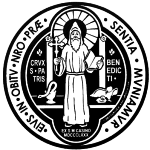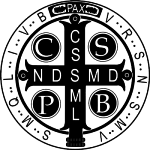The following description is extracted from The Medal or Cross of St. Benedict, by Dom Gueranger, the founder of our monastic congregation.

I. The Images on the Medal
A Christian needs but reflect for a moment on the sovereign virtue of the Cross of Jesus Christ in order to understand how worthy of respect a Medal is on which it is represented. The Cross was the instrument of the world’s redemption; it is the saving tree whereon was expiated the sin committed by man when he ate the fruit of the forbidden tree. The Cross, which the Church salutes as our only hope, “Spes Unica,” is to appear at the last day in the clouds of heaven, as the trophy of the victory of the Man-God. Animated by sentiments of the purest religion, the primitive Christians had, from the very beginning of the Church, the profoundest veneration for the image of the Cross, and the Fathers seem never to tire in the praises they give to this august image.
The Cross is an object of terror to the wicked spirits ; they cannot endure its presence; they no sooner see it, than the let go their prey and take to flight. In a word, of such importance to Christians is the Cross and the blessing it brings along with it, that from the times of the Apostles down to our own age, the faithful have ever been accustomed to make the sign of the Cross frequently upon themselves, and the priests of the Church have constantly used it upon all the objects, which in virtue of their sacerdotal character, they have the power to bless and sanctify.
Our Medal, therefore, which firstly offers to us this image of the Cross, is in strict accordance with Christian piety, and worthy, even were there no other motive than this, of all possible veneration. The honor of appearing on the same medal with the image of the Holy Cross has been given to St. Benedict with the intention of expressing the efficacy which this holy sign had when made by his venerable hand, he overcame his temptations, and broke the cup of poisoned drink which was proffered to him, thus unmasking the wicked design of those who had plotted to take away his life. The disciples of St. Benedict have had a like confidence in this sacred sign.
II. The Letters on the Medal
Besides the two Images of the Cross and St. Benedict, there are also inscribed on the Medal a certain number of letters, each of which is the initial of a Latin word. These words compose one or two sentences, which explain the Medal and its object. They express the relation existing between the Holy Patriarch of the Monks of the West and the sacred sign of the salvation of mankind, at the same time that they offer the faithful a formula which they may make use of for employing the virtue of the Holy Cross against the evil spirits.
Those mysterious letters are arranged on that side of the medal on which is the Cross. Let us begin by noticing the four which are placed near the Cross, one at each of the outward corners:
C S
P B
that is: Crux Sancti Patris Benedicti; in English: The Cross of Holy Father Benedict. These words explain the nature of the Medal. On the perpendicular line of the Cross itself are these letters:
C
S
S
M
L
they stand for these words : CRUX SANCTA SIT MIHI LUX; in English: May the Holy Cross be my Light. On the horizontal line of the Cross are these letters:
N D S M D
the words which they imply are: NON DRACO SIT MIHI DUX; in English: Let not the Dragon be my guide.
These two lines put together form a pentameter verse, containing the Christian’s protestation that he confides in the Holy Cross, and refuses to bear the yoke which the devil would limit upon him. Then below, beginning at the right hand, the following letters:
V R S N S M V S M Q L I V B
These initials stand for the two following verses:
VADE RETRO, SATANA; NUNQUAM SUADE MIHI VANA.
SUNT MALA QUAE LIBAS; IPSE VENENA BIBAS.
in English: Begone, Satan! and suggest not to me thy vain things; the Cup thou profferest me is evil; drink thou thy poison.
These words are supposed to be said by St. Benedict; those of the first verse when he was suffering the temptation in his cave, and which he overcame by the sign of the Cross; and those of the second verse, at the moment of his enemies offering to him the draught of death, which he discovered by his making over the poisoned cup the sign of Life.
The Christian may make use of these same words as often as he finds himself tormented by temptations and insults of the invisible enemy of our salvation. Our Saviour sanctified the first of these words, by himself making use of them “Begone, Satan!” Vade retro, Satana. Their efficacy has thus been tested, and the very Gospel is the guarantee of their power. The vain things, to which the devil incites us are disobedience to the law of God; they are also the pomps and false maxims of the world. The cup proffered us by this angel of darkness is evil, that is sin, which brings death to the soul: instead of receiving it at his hands, we ought to bid him keep it to himself, for it is the inheritance which he chose for himself.



